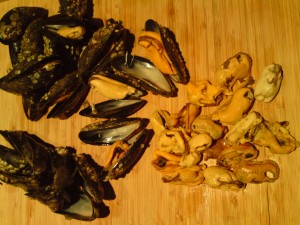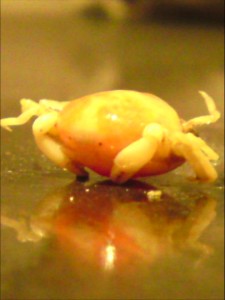Wild Mussels – Edibility, Harvesting, Safety, Depuration
- Healthy wild mussels are much meatier than their farmed cousins
Mussels – Mytilus edulis
Most people can easily recognise mussels, but not many harvest and eat them from the wild. This is largely due to fears over pollution and poisoning. While it is true that all filter feeders should be treated with caution, a little care and effort will minimise the risk and allow you to enjoy this superb wild food. They really are so much tastier and meatier than their farmed cousins. The best I have ever tasted came off an old pier on Arran. They were enormous (some 6 inches long) and covered in all manner of anenomes, urchins, starfish and slimy wriggling things of the deep. But once cleaned (by somebody else) they yielded the most sumptuous, flavoursome meat that totally filled their enormous shells.
First, stick to the general shellfish rule of not eating them when there isn’t an R in the month – May to August, as this is when they are in poor condition from spawning and they are more likely to harbour toxins, which do better in warmer conditions. Ensure that the area you pick from is open to the tides and free of any obvious sources of pollution (eg. sewage outfall pipes). Check for signs of red algae blooms in slow moving sea lochs. These aren’t alway obvious to the untrained eye, but cause such potential risk to wild shellfish eaters and swimmers that they are often well signposted. Check with the environment agency if you are unsure – SEPA in Scotland.
Once home, immediately immerse them in clean salt water (35g dissolved in each litre required) and leave somewhere cool for 8 -10 hours, aerating the water a couple of times if you can (blowing bubbles through an old squeezy bottle works). This goes some way to clearing them of grit and impurities. If kept cool, healthy mussels will last quite well in the fridge after this treatment, but it is best to try to cook and eat them as soon as possible after depuration – steam them open to remove the meat, or make classic moules a la mariniere with wild garlic and ground elder.
Pea crab (Pinnotheres pissum) – cute or creepy??
You should be warned that a fair proportion of wild mussels are likely to host the parasitic Pea Crab. Now I am not in the least bit squeamish, but I have to admit to finding them quite creepy with their little dots for eyes. My wife thinks they are cute, so maybe its just me! Anyway, you will find them nestling right inside the mussel meat, where they spend pretty much their entire life (hence the lack of eyes). Should you eat one, it isn’t a problem as they are tiny, soft and edible, tasting (unsurprisingly) of mussels.


11 Comments
Where is a safe place to collect mussels in Galloway and any advice on razor clams?
Many thanks
Thanks for your interest.
First please read this: http://www.gallowaywildfoods.com/?page_id=970
Info on mussels above.
Info on razors here: http://www.gallowaywildfoods.com/?page_id=229
We will be looking at shellfish on my May 6th and May 9th forays: http://www.gallowaywildfoods.com/?page_id=352
Maybe see you there, meanwhile,
Happy hunting,
Mark.
In Oklahoma I bought muscles 9 days post harvest…they had a foul smell next day and a foul liquid I did not eat them (pei) harvested. How soon should you eat them?
It depends on the condition of the mussels when harvested and how well they are looked after before eating. Any bad smell means throw them away! Likewise, any that fail to open when cooked are dead. The fresher the better with all shellfish!
To be fair they won’t be alive after you cook them will they..
Not sure what you mean by this Chode? They will be dead, but if they fail to open on cooking, they were dead before cooking, and should not be eaten. i.e.. they should always be cooked from live state.
Is it likely that I will become ill from picking wild mussels in June. The sea is clean and weather is at about 13°C, I live on the the east coast of Scotland.???
Probably not “likely”, but definitely “more likely”. The mussels are spawning at that time too, so as well as being undeweight/out of condition, you may be undermining future supplies…
Hi,
How far is a reasonable distance from a sewer outlet?
Thanks Mark
Thinking of picking mussles at Cloghey Co Down in Summer is that okay
Sorry, I can’t say what the water quality will be like then and there – though as I note in the post, wild mussels are not recommended in summer.